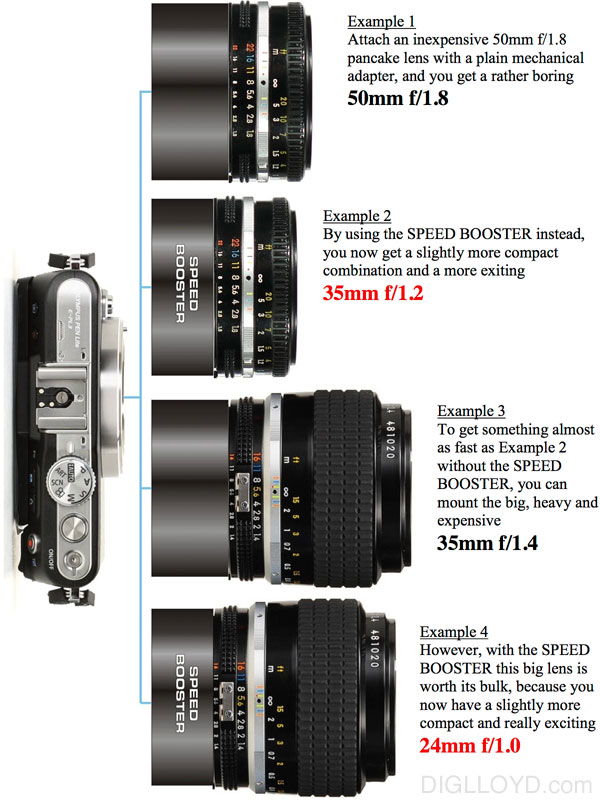Metabones Speed Booster — Comments from the Designer
See previous entry on the Metabones Speed Booster.
Brian Caldwell of Coastal Optics 60/4 UV-VIS-IR APO-macro fame developed the optical portion of the Metabones Speed Booster.
I want to see how the Speed Boster performs, but it sounds like mirrorless cameras have become even more attractive than ever before.
Brian Caldwell writes:
We designed an entirely separate optical system for micro 4/3. However, the magnification is the same as the NEX version: 0.7x. In order to get a significantly smaller magnification while maintaining excellent image quality we would have had to get much closer to the image plane with our optics. Unfortunately, the m4/3 cameras don't allow this.
The good news is that the performance of our 0.7x optics for micro 4/3 is really good, and I expect that some pixel peepers will prefer it over the NEX version. If you look at the MTF curves in the white paper you can see that the m4/3 version gives higher performance in the corners than the NEX version. We could have saved a lot of money by re-using the NEX optical cell for the upcoming m4/3 Speed Booster, but we decided to maximize image quality instead.
...
The problem with Leica M lenses is that they have a significantly shorter working distance than DSLR lenses. The glass in the Speed Booster is packed very tightly, so that there is just barely enough wiggle room to do a factory adjustment on infinity focus. If we tried re-design in order to accomodate Leica M lenses the image quality would drop like a rock.
We did debate whether to make the Speed Booster compatible with the Canon 50mm f/1 lens to provide a route to f/0.70 heaven. However, this would have required making the outer element of the Speed Booster much larger than it currently is, and this would have caused compatibility issues with other much more popular lenses. In addition, the Canon 50mm f/1 is discontinued, rare, and expensive, and even if you transformed it to a 35mm f/0.7 you might not be able to find a camera sensor capable of accepting an f/0.7 cone of light (~+/- 45 degrees for the extreme marginal rays). For all these reasons we decided to scrap the idea of trying for f/0.7.
Well, I’m glad that the Canon f/1 and similar too-compromised solutions were set aside.
The Speed Booster is good news for NEX users and great news for Micro Four Thirds users. And when m4/3 offers a 20 or 24m megapixel sensor (probably late 2013), things really start to get interesting.
Of considerable interest here it the fact that there is a shortage of fast lens designs for Sony NEX, Fuji X and Micro Four Thirds (Olympus, Panasonic). With the SpeedDoubler, suddenly we see a variety of useful options in the f/0.9 to f/1.2 range, all with common (and cheap) lenses (old Nikkors in particular).
I have an Olympus 50mm f/1.2 in Nikon mount, which if my calculations are correct becomes an f/0.86 lens, though the Speed Booster specs state a limit of f/0.9. It is a compact lens and might be interesting on the Olympus OM-D E-M5.
Netting out performance
Performance is a net effect: the MTF increases with the Speed Doubler, but Micro Four Thirds also has tiny photosites compared to full frame. Final performance remains to be seen as it actually nets out on any given combination of lens + camera.
MTF is also a function of the actual physical lens, not equations on paper, and real physical lenses always perform less well than the theoretical design.
I suspect that actual results on the smaller sensors will be less good than one might hope for, and will vary significantly between lenses. It remains to be seen (for example), whether wide open results are good really only for bokeh shots (due to limited sharpness), and whether results at f/4 - f/5.6 can deliver as good a sharpness as native mount lenses designed for the sensor.
Still, anyone with a stable of full-frame DSLR lenses now how a nice “lens cap” concept: attach various lenses to a Speed Booster on NEX or the Olympus E-M5 or whatever.
So what do I want now? I want a Leica S to Nikon F Speed Booster! Except that the mirror box gets in the way, so we’ll have to wait until Nikon makes a full frame F-mount mirrorless. Or Canon makes a full-frame EF mount mirrorless. But Brian Caldwell says:
I doubt a Speed Booster would work very well with a Canon camera either. You really need to get close to the image plane to start seeing really good performance.
Equivalents
Focal length and aperture are invariants, but there are both field of view crop factors and depth of field equivalencies that depend on the format (sensor size).
Field of view
Focal length is always what is is (the same lens is the same lens regardless of what camera it mounts on), but one still has to apply a “crop factor” for small sensor cameras.
APS-C (23.5mm wide sensor), a 35mm lens is equivalent in field of view to about a 53mm lens, a “crop factor” of ~1.52 (35.9 / 23.5).
So for the Speed Doubler, FOV equivalent for APS-C:
APS-C FOV equiv = F * 0.71 * 1.53 = F * 1.086
On Micro Four Thirds, a 35mm lens is equivalent in field of view to about a 70mm lens, a “crop factor” of ~2.0 (aspect ratios differ as 4:3 vs 3:2).
m4/3 FOV equiv = F * 0.71 * 2.0 = F * 1.42
F-stop and depth of field
A 50mm f/1.8 reduced to a 35mm f/1.2 on Micro Four Thirds is equivalent in field of view to a 70mm f/1.2.
But in terms of depth of field, that f/1.2 aperture is equivalent to f1.2 * 1.4 * 1.4 = f/2.4.
Furthermore, the faster shutter speed that f/1.2 allows (versus f/1.8) is offset by the much smaller photosite size on m4/3, which requires higher shutter speeds for the same amount of angular motion (camera movement).



























